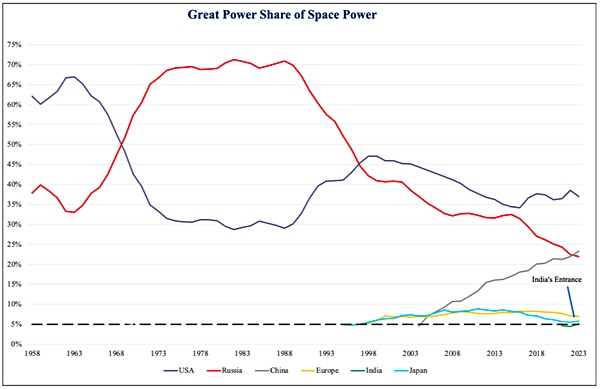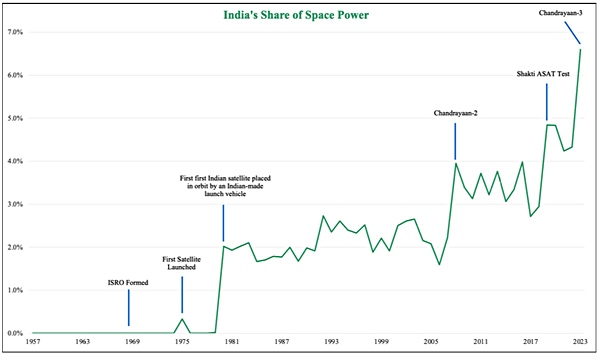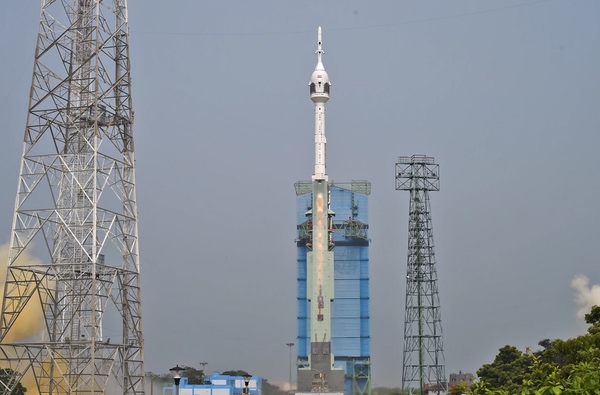Enter India, the fifth great space powerby Daniel Duchaine
|
 |
The (revised) Space Power Index
By now many of you are familiar with my Space Power Index (see “Is China’s rise in space over? Indexing space power for the next space age,” The Space Review, July 31, 2023). It is a quantitative measure designed to gauge the great space powers’ prowess in space (see the index and the data behind it here). Traditionally, when a state crosses 5% of the total share of space power, it is considered a great power (See Doran, C. (1991). Systems in Crisis: New Imperatives of High Politics at Century’s End).
Space power was based on cumulative payloads launched, scientific capabilities, and military capabilities. For this version, I included annual orbital launches, annual payloads launched, annual scientific payloads launched, and annual military payloads launched.
- Annual Orbital Launches: Total annual orbital launches shows a state’s space launch capacity. While a state can launch thousands of small satellites on one rocket, a state might need the capacity to launch many rockets at one time or in one short period.
- Annual Payloads: Annual payloads launches shows that a state has the technological capacity to design, build, and deploy space technology and that the state has a high industrial capability, required for launching large numbers of satellites.
- Cumulative Orbital Launches: I included cumulative orbital launches to account for a state’s satellite system. Satellites function even in the years after they are launched and should count towards space power for more than one year.
- Scientific and Military Achievements: Scientific and military achievements are inputs representing various milestones from a state’s first satellite launched to putting a human on the moon.
- Scientific and Military Annual Payloads: I also included the annual count of scientific payloads and military payloads a state launched. Separate from achievements, this shows that a state can support a full scientific or military satellite system.
By plotting these factors over time, we get a unique window into the ebbs and flows of a nation’s space capabilities. When the index shifts, it signals periods of changing expectations where conflict is more likely.
 |
The history of India’s space program
India began its journey to become a 21st century power in 1968, when the Indian Space Research Organisation (ISRO) was established. India took its first baby steps with the launch of the Aryabhata satellite in 1975. This was not just a technological feat; it was India claiming its first share in global space power.
In the 1980s, ISRO progressed from infancy to adolescence with the Rohini satellite, demonstrating not just technological prowess but self-reliance, as it was lifted by India’s own SLV-3 rocket.
| From 2019, India’s space power has seen a remarkable surge, attributed to both striking scientific missions and military capability demonstrations. |
For much of the late 20th century, India’s space activities remained largely confined to scientific payloads. However, the tide began to turn in the 21st century, as India made international headlines with significant scientific and military capability demonstrations. The 2008 Chandrayaan-1 mission was India’s first lunar expedition, and the successful 2013 Mars Orbiter Mission (Mangalyaan) made India the fourth nation globally to reach Martian orbit.
How India entered the space great power system
From 2019, India’s space power has seen a remarkable surge, attributed to both striking scientific missions and military capability demonstrations that have caught the world’s attention.
First, in 2019, the Chandrayaan-2 mission (accidentally) achieved a hard lunar landing, though it was far from a failure; the orbiter continues to send valuable data back to Earth. That same year, India’s successful anti-satellite (ASAT) weapon test, dubbed “Mission Shakti,” served as a powerful demonstration of the country’s burgeoning military capabilities in space.
By 2022 India held 4.3% of the share of space power, placing it just outside the great space power system. India’s ascent in the space arena was the successful landing of the Chandrayaan-3 mission in the south polar region of the Moon. This achievement not only shows actual space expertise, it also caught the attention of the world and shifted perceptions of India’s space power. Indices of power like the space power index ideally reflect real world perceptions. In my estimation, the moment Chandrayaan-3 touched down on the lunar surface was the moment that India became a great space power. With the inclusion of Chandrayaan-3 as a scientific achievement, India officially crossed the 5% threshold to 6.6% of the share of space power.
What’s next?
Despite recent news, India still does not launch many objects into space. As of 2022, India launched only 133 cumulative objects, trailing behind the other great space powers and even the UK. India’s annual orbital launches also lag behind, with only four in 2022 compared to the US’s 74, China’s 62, Russia’s 21, New Zealand’s 8, and the European Space Agency’s 5. There is no guarantee India will rise in space—Europe and Japan have never crossed 10% of the global share of space power—however, India is laying the groundwork for accelerating its contributions to space exploration and technology.
Earlier this year, India issued its first national space policy, a pivotal step for the nation. The policy addresses longstanding gaps by providing a regulatory framework that encourages private capital investment in the space sector. This move allows state institutions to focus on non-commercially attractive but critically important endeavors, such as basic science research and deep space exploration. The expectation is that this policy will spur an increase in the number of objects India launches into space, an area where it has thus far lagged. Moreover, the success of Chandrayaan-3 opens the doors for increased private sector involvement in the space industry. According to Bloomberg, Indian space stocks added $2.5 billion ahead of the Moon landing. Much of US space power comes from objects launched by the private sector, so if India can tap into this source of power, it could continue to rise.
While India has far to go to match the US, China, or Russia in space power, there is potential for India to continue its rise by increasing its volume of objects launched.
The geopolitical ramifications
India’s entrance into the space power system destabilizes the international order, making conflict more likely. The Power Cycle Theory of international relations argues that stability in the global system often hinges on the predictable trends of the share of power among states. When this equilibrium is disrupted—for example, by the rise of a new power—existing expectations can be upended, leading to increased competition and conflict.
| As India embraces its new role, it is incumbent upon policymakers, diplomats, and leaders to exercise caution and strategic foresight. Space is not just another domain but a frontier that holds collective implications for humanity. |
History offers cautionary tales about the perils of a newly emergent power disrupting an established order. The entry of Germany into the Vienna system in the late 19th and early 20th centuries, for example, upset a delicate balance among European powers, eventually precipitating the chaos of World War I. As Germany’s power grew, other major powers saw their relative share of power decline, causing tensions and undercutting the basis for cooperation. The Vienna system, which had provided a century of relative peace, could not sustain the new dynamics and ultimately collapsed.
India’s recently acquired status as a great space power undoubtedly recalibrates global dynamics. By obtaining a share of space power, India inherently eats into the rest of the system. Countries that perceive themselves as losing ground may resort to competitive behavior to hedge against India’s rise.
Conclusion
As India embraces its new role, it is incumbent upon policymakers, diplomats, and leaders to exercise caution and strategic foresight. Space is not just another domain but a frontier that holds collective implications for humanity. Its use—or misuse—could have far-reaching consequences. Therefore, India’s emergence as a space power is not just an opportunity but also a responsibility. International diplomacy and policies must adapt to include India in a framework that encourages cooperation while mitigating the risks of conflict. Other space powers must also rise to the occasion, recognizing the transformed landscape and working collaboratively to maintain stability.
The world is now looking at India not just as a participant but as a leader in space exploration and technology. This offers India a unique opportunity to set a precedent for how new powers should engage in the global system, balancing competition with collaboration. By acknowledging India’s evolving role and acting wisely, the global community can strive for a future where space remains a realm of human achievement and cooperation, rather than one of conflict and division.
Note: we are using a new commenting system, which may require you to create a new account.
